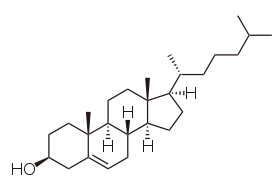Cholesterol
links: reference: 4-11-2021
Cholesterol
 #
#
Dietary #
- According to a few gas chromatography studies: in food, it is in the form of free cholesterol, cholesteryl esters (bound to fatty acids), free sterols, acetates, and an unsaponifiable lipid fraction.
- Increased levels of cholesteryl ester have been found in certain parts of the brain of people with Huntington’s disease disease… they transport cholesterol throughout the brain.
- ~10% of cholesterol in Egg yolks is esterified, but ~50% in Meat and eggs. They cannot be absorbed must first be hydrolyzed via cholesterol esterase from the Pancreas (which also cleaves Phytosterols)
- Free cholesterol/Bile on the other hand doesn’t require digestion and incorporates into micelles. That’s digestion, but it still must be absorbed. Bile salts allow micelles them to be water-soluble to penetrate Enterocytes and break down with it.
- Where sterol carrier proteins carry cholesterol through the cytosol. It is then esterified in the Endoplasmic Reticulum via acyl-CoA:cholesterol acyltransferase 2, required for Chylomicron formation.
- Uptake of cholesterol/Phytosterols by brush borders is mediated by NPC1L1 (’Niemann-Pick C1 like 1’ (compromised cholesterol absorption via NPC1 in Niemann Pick disease type C))
- Free cholesterol/Bile on the other hand doesn’t require digestion and incorporates into micelles. That’s digestion, but it still must be absorbed. Bile salts allow micelles them to be water-soluble to penetrate Enterocytes and break down with it.
- Regulatory mechanisms for high dietary intake include increased biliary excretion, and simply downregulation of synthesis.
- Biliary excretion of cholesterol itself, or perhaps bile. According to Advanced Nutrition, it contributes 800-1400 mg/day.
- If excreted into the intestine, ~50% of it is reabosorbed: Dietary Phospholipids and Intestinal Cholesterol Absorption (2010)
-
Cholesterol metabolism and homeostasis in the brain
- Primarily supplied by de novo synthesis, since Lipoproteins do not cross the BBB from circulation.
Synthesis #
-

- Statin drugs (and AMPK, Mevalonic acid, and LXR) inhibit that second one: HMG-CoA Reductase.